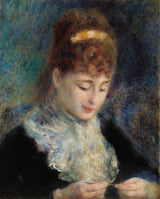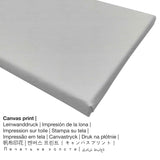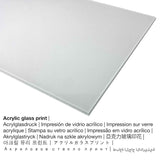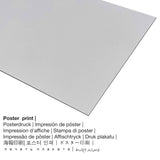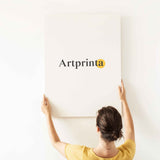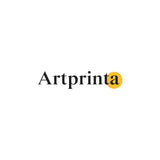Pierre-Auguste Renoir, 1877 - Woman Crocheting (Female Crocheting) - fine art print
Tax included. Shipping calculated at checkout.
The artwork "Woman Crocheting (Female Crocheting)" from Pierre-Auguste Renoir as your personal art copy
The more than 140 year-old work of art "Woman Crocheting (Female Crocheting)" was painted by Pierre-Auguste Renoir in 1877. The 140 year old artwork was painted with the size: Overall: 16 1/8 x 12 13/16 in (41 x 32,5 cm). Oil on canvas was applied by the European artist as the medium of the work of art. Today, the artpiece belongs to the art collection of Barnes Foundation, which home to one of the world's greatest collections of impressionist, post-impressionist and early modernist paintings. With courtesy of - Courtesy of the Barnes Foundation, Merion and Philadelphia, Pennsylvania (licensed - public domain).In addition, the artpiece has the creditline: . In addition to this, the alignment is in portrait format with a ratio of 1 : 1.2, meaning that the length is 20% shorter than the width. The illustrator, painter, sculptor Pierre-Auguste Renoir was an artist from France, whose artistic style can be attributed primarily to Impressionism. The European painter was born in the year 1841 in Limoges, Nouvelle-Aquitaine, France and deceased at the age of 78 in the year 1919.
Additional artwork information from the museum (© Copyright - by Barnes Foundation - www.barnesfoundation.org)
During the 1870s, alongside his ambitious modern life subjects such as Leaving the Conservatory (BF862), Renoir painted very many canvases of single figures; some of these were portraits, but many were more generic, showing unidentified figures, generally bust length, focusing on their everyday activities. Woman Crocheting is one of the most elaborated and highly finished of these canvases; despite its small scale, its treatment and signature show that Renoir intended it for sale, and it seems likely that the composer Emmanuel Chabrier, who also owned Leaving the Conservatory, acquired it soon after its execution, though we do not know when.In some of these single-figure paintings, the model is depicted informally dressed or revealingly posed in her undergarments, as in A Girl Crocheting of circa 1875. Here, by contrast, there is no such sensual appeal; the figure is fully and fashionably dressed, with an elaborate lace scarf, as she focuses on her crocheting. Her hair is held in place by a gold-colored hairband, and her lowered eyes deny the viewer any imaginative access toter expression. Indeed, of all Renoir's paintings of a single female figure, this is one of those that makes the least direct appeal to the viewer, in either empathetic or voyeuristic terms.Her facial features are treated with considerable delicacy but wholly without conventional draftsmanship. The lit side of her face is differentiated from the background by contrasts of color and tone, but its contours are soft, and the shadowed side of her head is gently blurred into the wall behind her. Alongside the pink of her face and hands and the red of her lips, her golden hairband and especially her light scarf act as focal points, set off against the darker hues of the rest of the picture. The ruff is handled with great freedom, in an array of variegated and seemingly spontaneous touches that hint at its form and fabric but wholly without descriptive detail. We cannot be certain, too, about the ruff's actual, local color; its highlights are white and pale cream, but much soft blue is used to suggest the fall of its material and the shadows in it. We are likewise left uncertain about the color of the model's hair, which is treated with varied strokes of red and blue and, on its lit side, soft yellows.The background does not merely act as a foil to the figure. It is delicately brushed, in fine strokes predominantly of blue and green with some soft yellow accents. However, despite the finesse of its execution, it is unclear what it represents. The more emphatic strokes to the lower right of the figure may suggest a sofa on which she is seated, but the area behind her head might be read as a wall covering or as some sort of foliage. In the treatment of areas such as these, Renoir was more concerned with integrating the background into the complex overall color-harmony of the canvas as a whole than with creating a legible illusionistic space.In broad terms, figures such as these carry echoes of the art of the French 18th century, for which Renoir held a lifelong interest; the small canvases of half-length female figures by Jean-Honore Fragonard and Jean-Baptiste Greuze seem especially relevant to canvases such as Woman Crocheting, though Renoir studiously avoided the sentimental and moral undertones that characterize Greuze's figures in particular.John House, Renoir in the Barnes Foundation (New Haven: Yale University Press, 2012), 91.
Structured artwork data
| Work of art title: | "Woman Crocheting (Female Crocheting)" |
| Categorization of the work of art: | painting |
| Broad category: | modern art |
| Century: | 19th century |
| Year: | 1877 |
| Artwork age: | 140 years old |
| Original medium of artwork: | oil on canvas |
| Dimensions of the original artwork: | Overall: 16 1/8 x 12 13/16 in (41 x 32,5 cm) |
| Museum / location: | Barnes Foundation |
| Museum location: | Philadelphia, Pennsylvania, United States of America |
| Museum's web page: | www.barnesfoundation.org |
| License type: | public domain |
| Courtesy of: | Courtesy of the Barnes Foundation, Merion and Philadelphia, Pennsylvania |
General information about the artist
| Name: | Pierre-Auguste Renoir |
| Alternative names: | Auguste Renoir, renoir p.a., p.a. renoir, Renoar Pjer-Ogist, Pierre Auguste Renoir, Renoir, firmin auguste renoir, רנואר אוגוסט, Renuar Ogi︠u︡st, Pierre-Auguste Renoir, Renoir Auguste, Renoir August, Renoir Pierre Auguste, renoir a., Renoir Pierre August, רנואר פייר אוגוסט, August Renoir, a. renoir, pierre august renoir, Renoir Pierre-Auguste |
| Artist gender: | male |
| Nationality: | French |
| Jobs: | sculptor, painter, illustrator |
| Country: | France |
| Artist category: | modern artist |
| Styles of the artist: | Impressionism |
| Lifespan: | 78 years |
| Birth year: | 1841 |
| Born in (place): | Limoges, Nouvelle-Aquitaine, France |
| Died: | 1919 |
| Deceased in (place): | Cagnes-sur-Mer, Provence-Alpes-Cote d'Azur, France |
Which art print materials can I pick?
We offer a range of various sizes and materials for every product. Therefore, we allow you to choose among the following options:
- Poster print (canvas material): The poster is a UV printed sheet of flat canvas paper with a slight surface structure, which reminds the actual work of art. Please note, that depending on the absolute size of the poster print we add a white margin of approximately 2-6cm round about the artwork in order to facilitate the framing with a custom frame.
- Metal (aluminium dibond print): This is a metal print manufactured on aluminium dibond with an outstanding depth effect, which makes a fashionable impression thanks to a non-reflective surface structure. The bright and white parts of the original artpiece shimmer with a silky gloss, however without glare. Colors are bright and luminous, the fine details of the print appear very clear, and there’s a matte look that you can literally feel.
- The glossy acrylic glass print (with real glass coating): A glossy print on acrylic glass, which is often referred to as a plexiglass print, will transform your favorite original work of art into beautiful wall decoration and offers a viable alternative option to canvas or aluminium dibond art prints. The artwork is manufactured with the help of state-of-the-art UV printing machines. This creates intense and sharp print colors. The major benefit of an acrylic glass print is that contrasts and also color details become more identifiable with the help of the precise tonal gradation of the picture.
- Canvas: A canvas direct print is a printed cotton canvas mounted on a wood stretcher. The great advantage of canvas prints is that they are relatively low in weight, which means that it is easy to hang up your Canvas print without any wall-mounts. That is why, canvas prints are suited for all kinds of walls.
Structured article details
| Article categorization: | art print |
| Reproduction method: | digital reproduction |
| Manufacturing method: | UV direct printing |
| Origin of the product: | produced in Germany |
| Type of stock: | production on demand |
| Product use: | wall décor, home design |
| Alignment of the artwork: | portrait alignment |
| Image aspect ratio: | length to width 1 : 1.2 |
| Implication of the image ratio: | the length is 20% shorter than the width |
| Material variants: | acrylic glass print (with real glass coating), poster print (canvas paper), canvas print, metal print (aluminium dibond) |
| Canvas on stretcher frame (canvas print) size options: | 50x60cm - 20x24", 100x120cm - 39x47", 150x180cm - 59x71" |
| Acrylic glass print (with real glass coating) size options: | 50x60cm - 20x24", 100x120cm - 39x47", 150x180cm - 59x71" |
| Poster print (canvas paper) options: | 50x60cm - 20x24", 100x120cm - 39x47" |
| Aluminium print (aluminium dibond material) size variants: | 50x60cm - 20x24", 100x120cm - 39x47" |
| Frame: | no frame |
Important information: We try everything to describe our art products as precisely as possible and to illustrate them visually. At the same time, the colors of the print materials, as well as the printing can diverge somehwat from the image on the monitor. Depending on your screen settings and the quality of the surface, not all colors are printed as exactly as the digital version on this website. Considering that all the fine art prints are processed and printed by hand, there may also be slight variations in the motif's size and exact position.
This text is intellectual property and protected by copyright © - Artprinta (www.artprinta.com)

